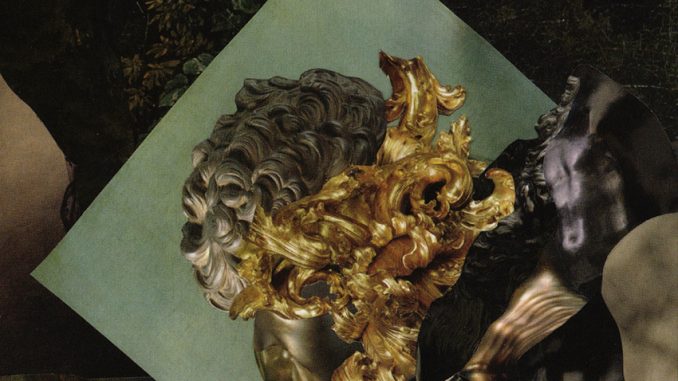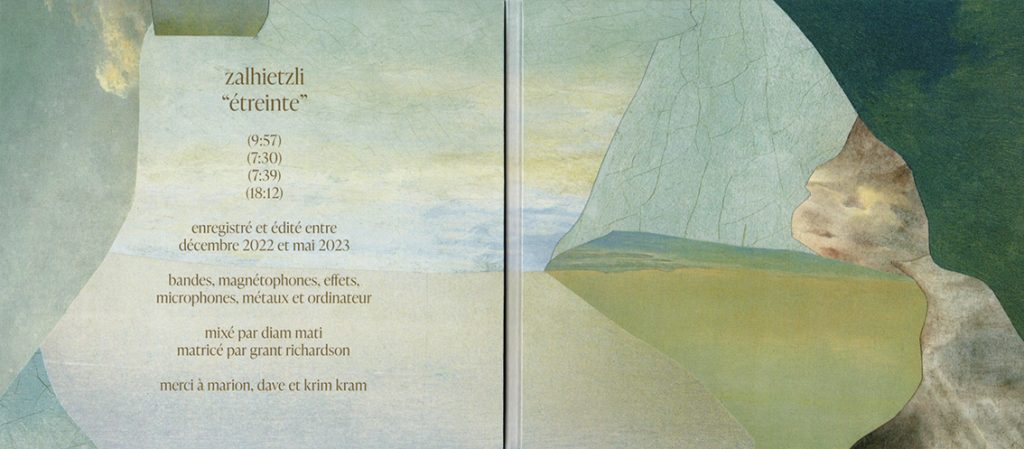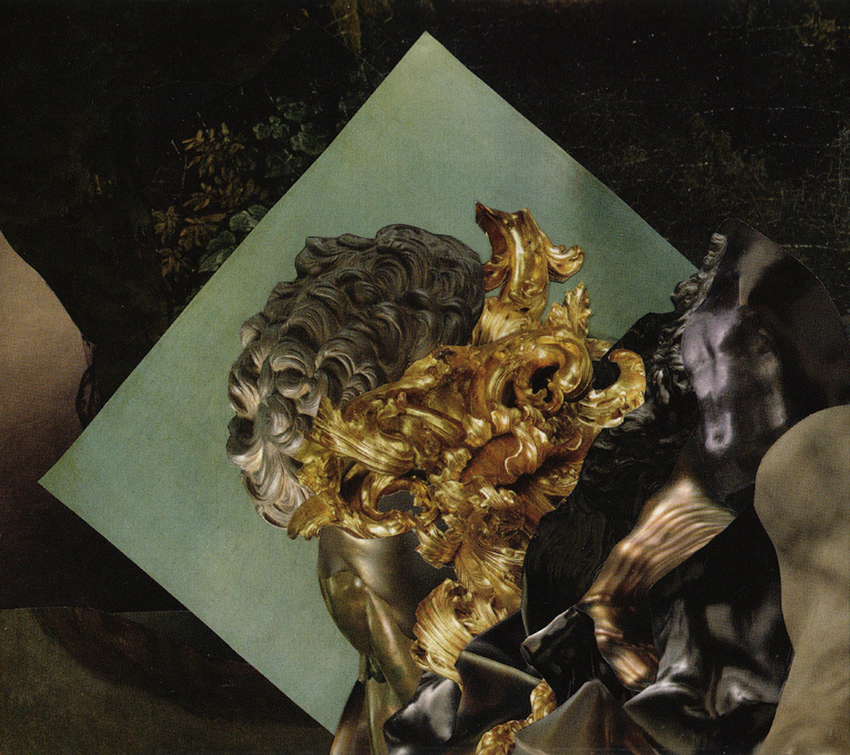

ZALHIETZLI – ÉTREINTE
Text: Mikko Polus
Zalhietzli’s releases have a fairly wide range. Le Foudroyé, the project’s tape on Satatuhatta that served as my initiation to the project, begins with a ridiculously tasty loop of somewhat fragile metal clatter and near-brutish tape warbles. That’s what got me hooked, but the project has scope from much more direct harsh noise with violent metal sounds, heavy use of cassette manipulation that ranges from noise to even drone bits, and extends all the way to the electronic microsound pieces on Main De Gloire CD-R. The fusion and interplay of varying types of hands-on cassette action, metal sounds and unspecified digital manipulations seems to be one of the project’s main features. It also means that you can’t really make too bold guesses in advance on what each new Zalhietzli release will sound like.
With this release, I was expecting something softer and “high-artsy” as the cover collage’s vibes of classical art too my brains to that direction, but I was immediately proven wrong with the roughly rattling tape warbles and muffled wails of metal the opening song starts with. The album overall operates on a palette that might seem narrow, but someone expecting the recipe of metal junks and tape manipulations to be “the same old thing again” will likely be surprised. While there are some heavy hits of loud metal and some of it is delivered through a heavily blown-out sound, there is very little of direct or hostile violence in the songs – but do note this certainly doesn’t mean lack of energy. They are not soft, but instead of an all-out attack, the sounds rather surround the listener and offer a continuously unfolding sight of vibrancy. Comparisons to machinery and insects might be lazy, but that’s where the album takes me: small machines starting and stopping, insects or other unpredictable creatures wandering, things lighting up and blooming and soon fading out or dying. The album’s title supposedly translates to “embrace”, so perhaps me imagining the album’s sound elements surrounding me has been an intended effect? The intensity of the sight is varied by the loudest and harshest metal rumbles, yet even at its loudest there are always more things to hear than a sheer mass of sound. The album isn’t afraid to quiet things down at times, and there is often some breathing air between the sounds to avoid overwhelming or suffocating the listener.
The album’s mixing was done by Diam Mati and mastering by Grant Richardson. While I haven’t had any complaints about the project’s production values on the earlier releases I’ve heard, this one still seems to go a notch further. There are moments where the sole sound source seems to be just a hum of a blank tape amplified and played through a crackling speaker or a breaking connection, yet the resulting sound is thick and detailed instead of seeming weak or lo-fi. That means that the quieter and “smaller” sounds have no issue in finding a working balance between all the louder and harsher sounds.
The interplay between metals and tapes makes each element shine with their strengths, and the digital edits give an additional element of things somehow not sounding like you’d expect. This is in no way “digital noise” in the sense of the immediate allergic reaction it might cause some, but you can hear how some sounds and tweaks have been taken further into weirdness through digital editing. This mixture of seemingly opposite approaches makes it slightly more challenging for me, and I mean that in a positive sense. It defies my expectations and makes me enjoy some twists and turns that I wouldn’t immediately think I would. [edit: Based on the interview replies you can find at the end of this review, it seems that some edits I thought were computer-based were instead done on an Elektron Machinedrum. Living is learning!]
The album consists of four tracks that total in about 43 minutes, which feels pretty optimal. Each track has variation both within and between them, from a heavier focus on metals, tape warbles or post-editing, so despite featuring quite a rich mass of movement and details it doesn’t wear you down. When the album ends to a sudden fade, it feels like a surprise instead of something you were already waiting to happen.
Zalhietzli has mainly published tapes and CD-R’s this far, but this album was published as a pro-CD in 4-panel digifile covers by the label Krim Kram (who’ve also published releases from projects like Cyess Afxzs, Dressing, Arv & Miljö and Kapotte Muziek). I mentioned the artist’s self-made cover collage earlier (which is also included as a small poster that comes with the album), but perhaps even more so I liked the inside collage that looks like a calming icy landscape, yet seems to be quite crudely cut together. Crude, artistic and captivating – much like the album itself.
Album on Bandcamp: https://krimkram.bandcamp.com/album/treinte

Some of the gear you used is listed simply as effects and a computer, with no specifics given on what kind of effects were used and what kind of editing has been done. Unless this is some intented mystique, could you tell us something more about the tools you used?
Of course. I did not want to go into too much detail in the liner notes, as I wanted people to focus more on the object, visuals and sounds. Now if people are curious enough to check this interview, I don’t mind explaining it more.
For the hardware part, I used mostly cheap or DIY equipment. Beyond the usual junk metal and contact mic, the two main units I used for this album were a Lux Sound mixer and a Zoom MRS-4 digital recorder. I used them as no-input mixers, distortion units, or a mix of both. The Lux Sound mixer makes up most of the first track, and the Zoom recorder was used extensively on the last track. On these two tracks I also used an Elektron Machinedrum to get the glitchy granular sounds, similar to the technique I used on the Talweg tape that came out on Bent Window Records. The second track features a Boss RPS-10 delay/pitch shifter unit, with some sessions recorded to tape before being transferred to the computer. I think it’s the only track without any “microphone sounds”, only no-input. On the third track I used a lot of tape loops with junk metal sounds recorded live with a modded Tascam Portastudio 414.
I did not create any sound with the computer, I only edited the recordings on Reaper, adding some EQ, volume and pan automations. That said, I wanted to mention the computer alongside the other instruments, as this editing phase took about 80 to 90% of the time I spent working on this album. When I started recording I didn’t have any track concept or outline in mind, just sounds ideas and set-up I wanted to try out. I recorded improvised sessions that I worked into the finished tracks. I listened to them over and over, judging their progression, how they flowed together, what they lacked, etc. That critical listening part is what I spent the most time on. The actual “work” was moving parts around in Reaper to see what I could make better and make several alternate versions of tracks. It was like a big puzzle without a predetermined solution. I think I sent the label 2 draft versions of the album before settling on its final form, each time sayin “Ok, what I sent you before sucks, here’s a better version”. In retrospect I think there’s maybe a couple parts that I would have done differently, but I am still extremely happy with this album.
The album’s making time is listed as December 2022 – May 2023. Did you also create the collage artwork around the same time as you were working on the sounds, or were they created separately? Do you do collages for other purposes (or people) than to accompany your own sound releases?
I created the artwork and album layout after the music. This process mirrored the creation of the music, albeit much faster. Carefully selecting parts, arranging them in various configurations and taking the time to judge the results. Except for the text layout and the juxtaposition of the front and back artworks, everything is 100% analog collages, all sourced from the same art book. That visual part was extremely important to me, and I am very grateful to Dave (Krim Kram label) for agreeing to make a full size poster of the cover artwork. This poster is about the same size as the original collage piece, only slightly larger.
I also do collages as an art form in itself. I self-released a couple of zines a few years ago, and did an exhibition in a record store earlier this year. I did collages for other artists when I had a music label (Zugzwang Productions), but that was a long time ago ! I wouldn’t mind trying it again, if someone contacted me for it.
What is the story or meaning behind the album’s name?
To fully explain why I chose this title, I have to talk about my previous full-length album “Armure”. I see the two albums as a kind of diptych, with similar themes and techniques (even in the artworks : both collages are sourced from the same book). Armure is French for “armour”. I like its ambivalence as an album title. It evokes war, fighting, action but it’s a passive object. You can’t attack or take action with an armour. You only shield yourself from the outside world, the good and the bad. Obviously I did not choose this word with any reference to military themes. It was a metaphor of my relationships with people, friends and family at the time.
Étreinte is French for “embrace”. Similarly, it’s an ambivalent word, with either positive or negative connotations : it could be a hug, a warm embrace, or a stranglehold. The opposite of defense and sheltering.
Up until this point, my music was never connected to my personal experience like that. I used to choose album/track names and artwork because I thought they looked “cool” and vaguely mysterious. So it felt pretty intimidating and cathartic to put so much of myself into it, even though there is no trace of this in the sound or artwork ; no liner notes, sound samples, personal photographs… I don’t even think you need to know or care about all this to enjoy the music, it was something I had to do for myself firstly.
Did you approach the label Krim Kram, or did they reach out to you? Are they a label that you were previously familiar with?
Dave from Krim Kram contacted me shortly after the release of “Le Foudroyé” on Satatuhatta. I was familiar with this label from their reissue of the EXCELLENT first two Dressing tapes on CD. So when Dave reached out for an album I was really honored and happy. I must thank him again for his patience and trust. He’s great.
This album was published just recently in April 2024, but I’ll still be a dullard and ask if you’re already working on new releases, or even have something completed and coming up?
I finished working on this release in summer 2023. I thought I would slow down but I kept myself busy by creating a music video for a track from Armure and a digital cut-up instrument on PureData. As for new releases, I have a 3″ CDr coming out on Abhorrent After Death. I wanted to do something shorter with a much simpler creative process. It will feature a lot of that cut-up instrument. I also have a first draft for a new album coming on an American label. I will try to slow down and give it the time it needs.
Linktree: https://linktr.ee/zltz
Contact through the contact form of https://zltz.bandcamp.com/
or through instagram at https://www.instagram.com/zalhietzli/
